3 models, one better than the other: the Vesuvius fireplace stove is a laureate of industrial exhibitions
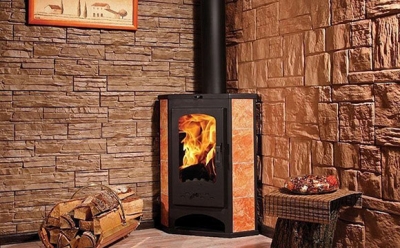
Tula Production Company "Vesuvius" has been producing furnace equipment for over ten years. The company's designers rely on the experience of domestic and Finnish production in their projects.
Products under the Vesuvius brand occupy leading positions on the Russian market And is able to compete with European manufacturers. At the same time, PTC Vesuvius has repeatedly become a laureate of industrial exhibitions in Russia and abroad. The company's product range includes stoves, fireplaces, smokehouses, chimneys and additional equipment.
Features of the Vesuvius fireplace stove model series
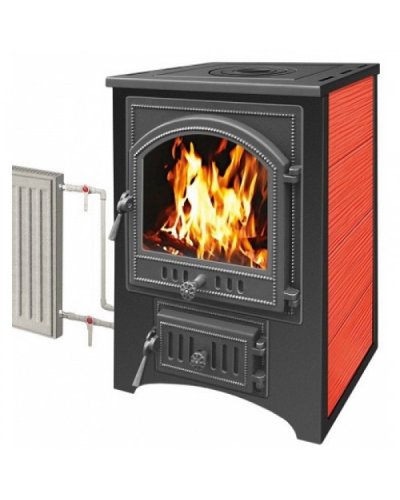
Taking into account the interests of consumers, PTC Vesuvius produces fireplace stoves with various additions: hobs, heat exchangers, auxiliary elements.
Installation of a chimney fireplace is provided in two versions - upper and rear.
The lining of the fireplace firebox involves simple replacement of fireclay if necessary, which is relevant given the manufacturer’s stated ten-year service life of the product.
The entire range of fireplace stoves It is produced under the designation PK-01 and has a common basic design:
- high quality steel body, supplemented cast iron elements: hob, grate and doors;
- combustion control system for two modes: intense for quick heating/cooking and long lasting for maintaining heat;
- cast iron firebox door with heat-resistant glass — due to the properties of the alloy, it is not subject to shape distortion when heated, which is typical for metal products.
Attention! Deformation of the firebox door not only leads to the splitting of expensive heat-resistant glass, but also causes a loss of tightness, therefore, reduces the efficiency of the unit.
All series of fireplaces are designed for installation of a chimney diameter 115 mm. Moreover, each model range has its own characteristics.
PC-01 205
Series PC-01(205) designed for indoor use volume up to 200 cubic metersAll fireplace models are equipped with a hob and have a pipe for installing a fan.
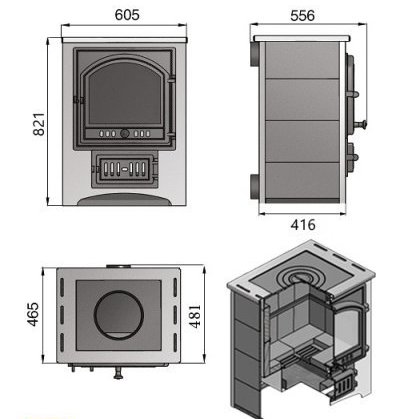
Includes the following instrument sets:
- PK-01(205) basic version without water circuit, without baffle;
- PK-01(205) with a stainless steel toothed baffle installed to optimize the combustion process in the firebox;
- PC-01 (205) with a water circuit to improve heat exchange;
- PC-01 (205) with a water circuit and an installed baffle plate.
Fireplace sizes: height/width/depth — 821/605/556 mm.
Weight 195-197 kg (for stone cladding), 171-175 kg (for ceramics).
The models are produced in four types of cladding: sandstone, talc chlorite, red and beige ceramics. This model range is available for wall-mounted installation only.
PC-01 220 angular
PC-01(220) — a series of corner fireplaces for heating rooms with a volume of up to 150 cubic meters Due to its lower power and simple configuration, the PC-01(220) is the most budget-friendly item in the product range.
Includes the following types of devices:
- PC-01(220) basic version, without a bump stop;
- PC-01(220) with a stainless steel toothed baffle installed to optimize the combustion process in the firebox.
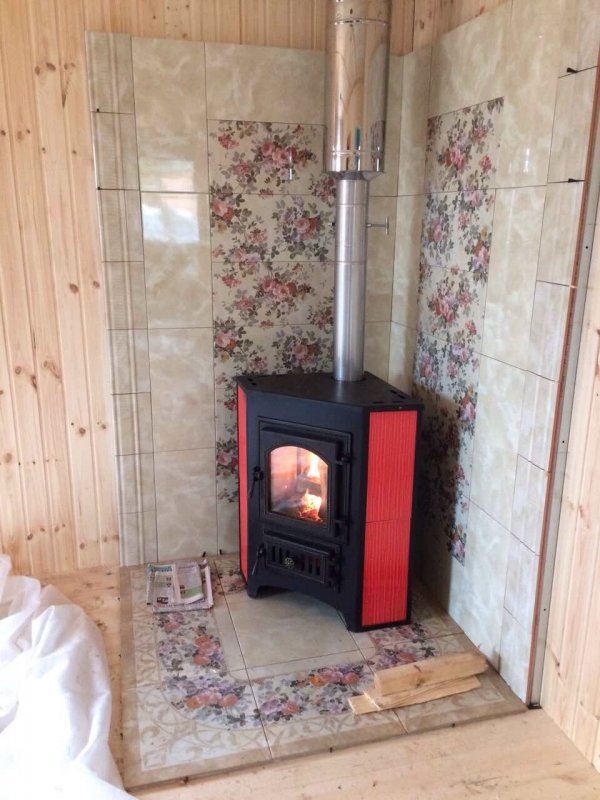
Photo 1. Corner fireplace stove "Vesuvius". The area around the stove is tiled to prevent the surrounding surfaces from catching fire.
Device dimensions: height/width/depth — 843/752/586 mm
Weight 120-132 kg (depending on the set).
Fireplaces have four types of cladding: sandstone, talc chlorite, red and beige ceramics. The series does not include fireplace models with a hob, heat exchanger or electric fan installation.
PC-01 270
As well as PC-01(205), series PC-01(270) can heat rooms with a volume of from 150 to 200 cubic meters. All models have the ability to connect a fan and are equipped with a stainless steel counter-tooth. They differ in the design of the firebox: The bottom is made of three cast iron grates, which reduces the risk of burnout and increases operational reliability.
Types of equipment:
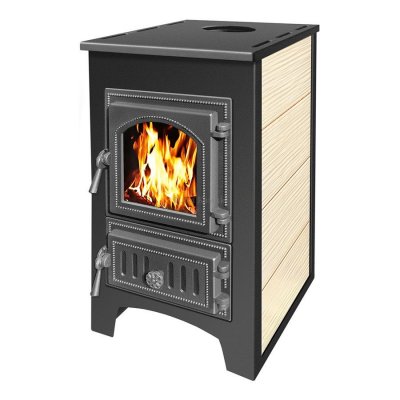
- PK-01(270) basic version without a hob, without a heat exchanger;
- PC-01(270) with a hob, without a heat exchanger;
- PC-01 (270) with a hob and a water circuit to improve heat exchange.
Fireplace sizes: height/width/depth — 821/438/517 mm.
Weight 195-197 kg (for stone cladding), 171-175 kg (for ceramics).
The models are available in the brand's standard trim: sandstone, talc chlorite, red and beige ceramics. The model range is suitable only for wall-mounted installation.
The PC-01(270) series costs first place in efficiency and reliability, thanks to additional equipment, but these qualities lead to a natural price increase.
Recommendations for selection
To select the optimal model of a fireplace stove It is important to determine the following parameters:
- volume of the heated room;
- installation location;
- functional load;
- heating mode.
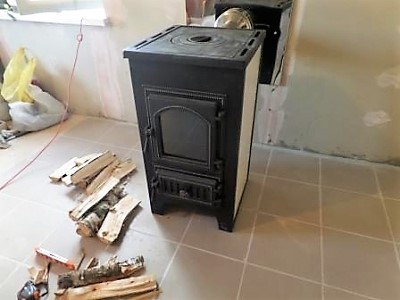
So, for small spaces (country houses, country buildings) with temporary residence, and, accordingly, periodic load of the fireplace, the basic version PK-01(270) for wall mounting or PK-01(220) for corner mounting is sufficient.
If the fireplace is also used for cooking, the PK-01(220) series is excluded. due to the lack of a hob. The choice will fall on the models PK-01(205) or PK-01(270) with a hob.
Series PC-01(270) is distinguished by its particular reliability and is recommended for heavy loads and intensive use, making it suitable for permanent residences.
The presence of partitions in the room prevents heat exchange. In this case, for heating efficiency, it is worth taking a closer look at the models with electric fan and water circuit.
Useful video
Watch a video review of the Vesuvius fireplace stove, in which the device is compared with a stove from another manufacturer, and the operating time from one load of firewood is calculated.
Advantages and disadvantages of Vesuvius fireplace stoves
Analyzing the proposals of heating equipment manufacturers, experts highlight Leading technical and operational characteristics of the Vesuvius fireplaces:
- the presence of injector-afterburners that increase the efficiency of solid fuel furnaces;
- cast iron cooktop thickness 15 mm;
- area of ceramic tiles 0.266 sq.m;
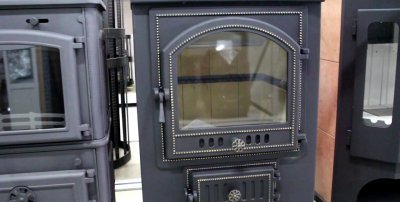
- heat exchanger capacity 1.5 l;
- firebox depth 32 cm.
Today, the PK-01 series fireplace stoves are one of the best offers in terms of price and quality in their segment.
The disadvantages of fireplaces include:
- difficulty in cleaning the chimney due to its design features;
- the appearance of rust on steel parts in high humidity;
- service life of cast iron 30 years old, but the use of metal at high temperatures is designed for a shorter period (about a year), which does not exclude the possibility of burnout;
- With intense temperature changes, cases of cladding splitting have been observed.






Comments